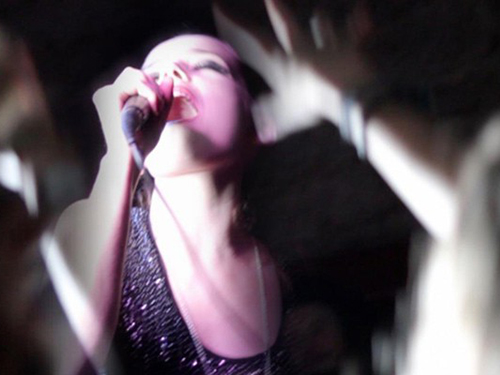
Philippe Grandrieux: You film with a history behind you. It’s hard to film as if Dreyer, Murnau and Lang had never existed. But I never think of antecedents as I film a shot; I couldn’t. I don’t have a cinephile background. My cinematic culture was formed late. When I was eighteen, nineteen, I’d only seen regular films like The Guns of Navarone (1961) – which, by the way, I liked a lot! But I had an urge to make films and, in the course of my studies at INSAS in Brussels, I discovered three films a day, seeing things that I had no idea existed. I remember Moses and Aaron (1975) by Jean-Marie Straub and Danièle Huillet, that was a blow, an aesthetic and political shock. I still recall it today. Suddenly – cinema.”
Nicole Brenez: A reinvention of thought – not discourse, thought.
And what came through bodies, fragmented bodies, legs, the extremely flat earth, the sunlight at its zenith, the brutality of the shots. All of that struck me. I was motivated. My cinephilia has constructed itself in a fragmentary way, but it’s not like there is cinema on one side, and literature and philosophy on the other. All of it is part of the same question, the same attentiveness, the same enterprise.
Philippe Grandrieux in an interview with Nicole Brenez1
“Philippe Grandrieux occupies a paradoxical place in the landscape of contemporary cinema production; the only truly comparable figure (whose work is, nonetheless, entirely different in its configuration) is another French filmmaker who is even less well known on the world stage, François-Jacques Ossang (Dharma Guns, 2011). Grandrieux, like Ossang, is not easily assimilable to any specific market category which his work, nonetheless, touches upon: art cinema, minimalist cinema, extreme cinema, underground cinema. His work is highly aesthetic (with very elaborate reference to, for example, the history of painting) – and yet it is also frequently brutal, dealing with matters such as serial rape-and-murder (Sombre, 1998), sex trafficking in Eastern Europe (La vie nouvelle / A New Life, 2002), and the clandestine making of pornographic snuff movies (Malgré la nuit). On the level of manifest content, this is the first evident affinity between Grandrieux and Artaud:
And that is why all the great Myths are dark, so that one cannot imagine, save in an atmosphere of carnage, torture, and bloodshed, all the magnificent Fables which recount to the multitudes the first sexual division and the first carnage of essences that appeared in creation. The theatre, like the plague, is in the image of this carnage and this essential separation. It releases conflicts, disengages powers, liberates possibilities, and if these possibilities and these powers are dark, it is the fault not of the plague nor or the theatre, but of life. (Artaud 1958, 31)’”
Adrian Martin2
Michael Glover Smith: [...] I feel like your conception of mise-en-scène is to capture bodies in space and to create choreography between the performers, and between the camera and the performers. To what extent do you decide what’s going to happen when you’re on location with the actors?
Philippe Grandrieux: Well, it depends on the scene. Usually when I shoot, I shoot very quickly. I take time to prepare the movie, to cast, scout for the places and a lot of time the preparation for the light. So I take a lot of time in this moment of the production of the movie. But when I shoot, I shoot very quickly. Sometimes then with the actors, I take the camera and I’m beginning to shoot and they don’t even know exactly what I’m going to do. And I speak when I shoot, so I give indications, you know? But it’s not improvisation because it’s trying to be together with the actors and trying to find together the same way to walk. You know when you walk with somebody sometimes you haven’t the same rhythm? You are against the rhythm of the other. So you always have to do one foot more to be in the same line. Do you know what I mean? And this rhythm is very important. You have to be in the same tempo.
Philippe Grandrieux in an interview with Michael Glover Smith3
“Since his startling debut feature, Sombre, Grandrieux has become one of cinema’s most audacious chroniclers of society’s underbelly, maybe even its best articulator of heightened sensations; despair and ecstasy erupt from the fabric of his films with a blistering, almost physical intensity. While Grandrieux’s fourth fiction feature continues his usual investigation into the limits of experience and range of cinematic possibilities, there’s also a strong willingness here to work along a more traditional narrative scheme. Not that Grandrieux has totally softened up. Malgré la Nuit still plays out like a sordid nightmare straight out of Georges Bataille’s imagination.”
Sean Nam4
- 1Nicole Brenez, “The Body’s Night. An Interview with Philippe Grandrieux,” Rouge, June 2003.
- 2Adrian Martin, “A Magic Identification with Forms: Philippe Grandrieux in the Night of Artaud,” Image & Narrative, Vol. 17, No.5, 2016.
- 3Michael Glover Smith, “Interview with Philippe Grandrieux,” Off Screen, Volume 20, Issue 4, April 2016.
- 4Sean Nam, “Film Comment Selects 2016 Malgré la Nuit,” Slant Magazine, 17 February 2016.

